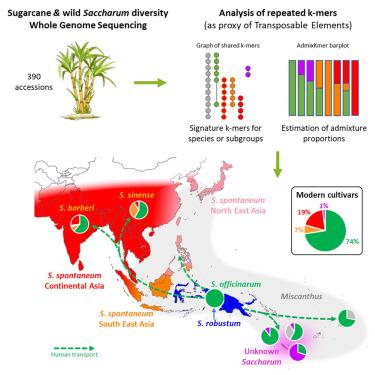The genomic footprints of wild Saccharum species trace domestication, diversification, and modern breeding of sugarcane
IF 42.5
1区 生物学
Q1 BIOCHEMISTRY & MOLECULAR BIOLOGY
引用次数: 0
Abstract
Sugarcane is a major crop of unclear origins due to its complex polyploid interspecific genome. We analyzed genome ancestries using whole-genome sequence data from 390 representative accessions based on repeated k-mers and chloroplast phylogeny. The results provided evidence that Saccharum officinarum was domesticated in the New Guinea region from the S. robustum wild species and revealed that its genome is a mosaic involving different S. robustum subgroups. We discovered a wild Saccharum contributor to most modern cultivars, likely originating from East Melanesia. We highlighted two early centers of sugarcane diversification associated with human transport, one in continental Asia through hybridization with different S. spontaneum subgroups and one in the Melanesian and Polynesian islands via hybridization with the discovered ancestor and Miscanthus. Finally, we revealed the genome ancestry of modern cultivars, highlighting untapped wild Saccharum diversity as a source of alleles for breeding programs.

野生甘蔗物种的基因组足迹追踪了甘蔗的驯化、多样化和现代育种
甘蔗是一种起源不明的主要作物,由于其复杂的多倍体种间基因组。基于重复k-mers和叶绿体系统发育,我们利用390个代表性品种的全基因组序列数据分析了基因组祖先。结果表明,在新几内亚地区,officinarum是由野生的S. robustum驯化而来,其基因组是由不同的S. robustum亚群组成的嵌合体。我们发现了一种对大多数现代品种都有贡献的野生糖精,可能起源于东美拉尼西亚。我们强调了与人类运输相关的两个早期甘蔗多样化中心,一个是通过与不同的S. spontanum亚群杂交在亚洲大陆,另一个是通过与发现的祖先和芒草杂交在美拉尼西亚和波利尼西亚群岛。最后,我们揭示了现代品种的基因组祖先,突出了未开发的野生糖精多样性作为育种计划的等位基因来源。
本文章由计算机程序翻译,如有差异,请以英文原文为准。
求助全文
约1分钟内获得全文
求助全文
来源期刊

Cell
生物-生化与分子生物学
CiteScore
110.00
自引率
0.80%
发文量
396
审稿时长
2 months
期刊介绍:
Cells is an international, peer-reviewed, open access journal that focuses on cell biology, molecular biology, and biophysics. It is affiliated with several societies, including the Spanish Society for Biochemistry and Molecular Biology (SEBBM), Nordic Autophagy Society (NAS), Spanish Society of Hematology and Hemotherapy (SEHH), and Society for Regenerative Medicine (Russian Federation) (RPO).
The journal publishes research findings of significant importance in various areas of experimental biology, such as cell biology, molecular biology, neuroscience, immunology, virology, microbiology, cancer, human genetics, systems biology, signaling, and disease mechanisms and therapeutics. The primary criterion for considering papers is whether the results contribute to significant conceptual advances or raise thought-provoking questions and hypotheses related to interesting and important biological inquiries.
In addition to primary research articles presented in four formats, Cells also features review and opinion articles in its "leading edge" section, discussing recent research advancements and topics of interest to its wide readership.
 求助内容:
求助内容: 应助结果提醒方式:
应助结果提醒方式:


